Franklin's Sex Tech: The Tormentor
I’ve moved some of my weird mad-science sex stuff to its own site: Tentacle.love.
The Tormentor was born of an idea to try to create a sex toy that would always be intrusive, always be in the foreground of your mind, but would never allow the wearer to have an orgasm.
The idea behind the Tormentor is that constantly varying stimulation never allows your sensory nerves to habituate. Any kind of steady, unvarying sensory stimulation will eventually fade into the background...but what if it were possible to create a wearable vibrator that one could wear around town, that would always run in a varying, unpredictable pattern without ever being quite enough to cause orgasm? Wouldn't that be fun?
I built the first version of the Tormentor using a common "egg" style vibrator, an Arduino Uno, and a simple motor controller. Since I made this prototype, several Arduino shields have come on the market (most notably Kyle Machulis' Pen15 board and the Master Beta kit from Orgasmatronics) that make interfacing a vibrator to an Arduino even easier.
The first wearable version of the Tormentor was assembled in a small plastic box I bought from Radio Shack. I actually got most of the components from Radio Shack, which will tell you how long ago I built it. I went there wearing bunny ears, which got quite a number of puzzled questions from the staff. The assortment of parts I was buying also got quite a number of puzzled questions from the staff, and the answers I gave led to even more questions, and...yeah. You get the idea.
One of the people who works at the local Radio Shack is a rather fetching young woman named Ashley, which by some complete coincidence is the same name as the person I lost my virginity to in the threesome oh so many years ago. I refrained from flirting with her.
The plastic box needed to be wide enough to accommodate the Arduino board that lives at the heart of the Tormentor. I opted to power the Arduino from a 9-volt battery (which probably wasn't the greatest choice--more on that in a bit), so it needed to be long enough for both the Arduino and the battery. The only box Radio Shack sells that fit the bill was much deeper than I would have wanted, though that turned out to be a good thing.
The actual interface between the Arduino and the vibrator is quite simple, consisting only of one resistor, one TIP120 Darlington transistor, and one diode. Here's the schematic:
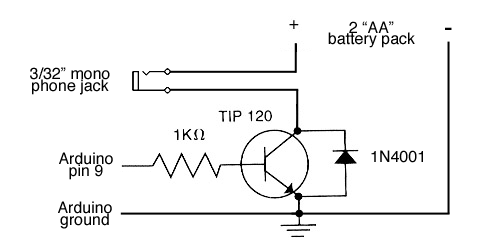
I built the test version by soldering the components directly to each other and taping them to the vibrator battery pack, but that was a little fragile, so I decided that the 0.2 version would use a small Radio Shack breadboarding circuit board cut down to a small (roughly postage stamp sized) square with a hacksaw.
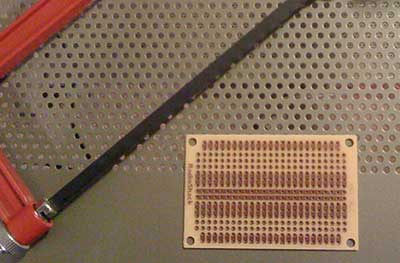
I opted to use a 3/32" phone jack to connect the vibrator to the Tormentor, because there are a number of vibrators with detachable battery packs floating around out there, and they all seem to use a 3/32" jack to connect the vibe to the battery pack.
I started out by mounting a 9V battery clip in the bottom of the box, then mounting the Arduino in the box using velcro straps so it could easily be removed.
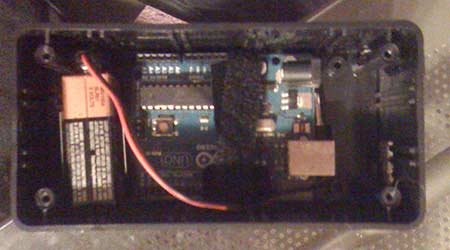
I hacked a hole in the side of the case big enough to, I thought, stick a USB cable in so I could reprogram the Arduino without taking it out. That idea worked rather less well than I had expected it to.
Two changes I made to the 0.1 prototype involved adding a power switch and a pair of LEDs, one red and one green. The red LED would be a power indicator; the green LED would light whenever the vibrator was running, so that observers would be able to see when it was on. The vibrator itself would run from two AA batteries, independent of the 9V battery that powered the Arduino.
I soldered the LEDs together to use a common ground with a common dropping resistor; the idea was to drive the power LED from the +5 pin on the Arduino, and to drive the "sexual torment" LED from a digital outpit pin on the Arduino that would be programmed to go high whenever the vibrator ran.
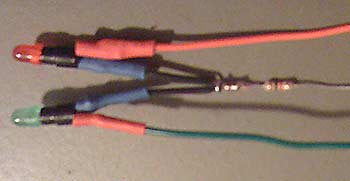
I originally was going to mount the LEDs one beneath the other on the box, but after drilling the holes, realized that it would block access to the USB cable that I thought I might be able to use for on-the-fly reprogramming. So I remounted them side by side on the box.
As it turns out, the USB cable really can't be used when it's assembled anyway; I do need to take the Arduino out to reprogram it. So I needn't have bothered.
You can see here how I intended to mount them, and how I eventually did mount them. The 0.2 prototype has an extra hole where I moved the sexual torment LED.
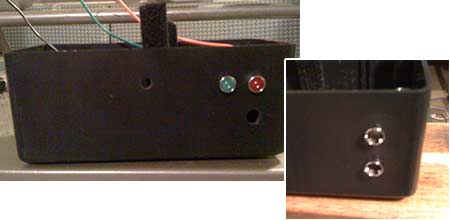
I wired in the LEDs and power switch and used a hot glue gun to glue the wires along the inside of the case. When I added the 3/32" phone jack to the top, I did the same thing with it, and also hot-glued in the little circuit board with the interface components.
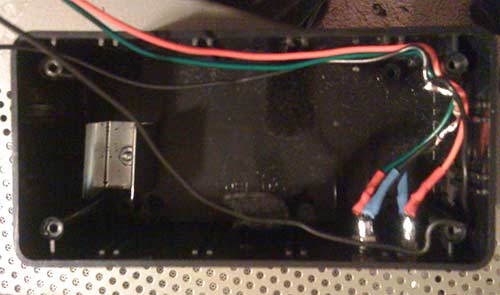
I also hot-glued the AA battery holders for the batteries that run the vibrator to the top of the case.
By the time it was all done, the box was pretty packed. It's awfully bulky, and could easily be made smaller with a bit of redesign.
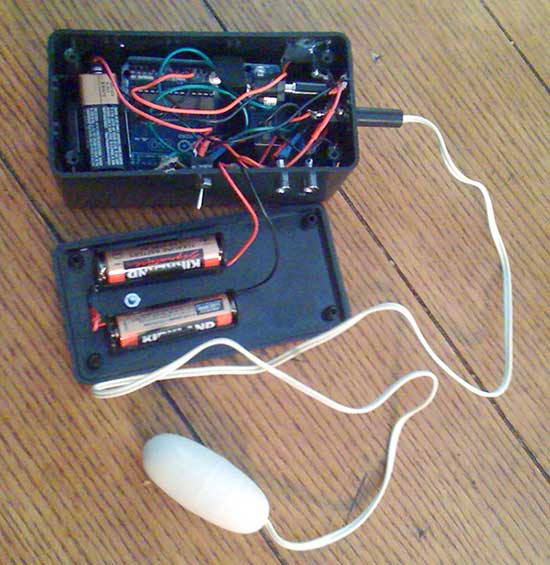
Here's what the final, completely assembled Tormentor prototype looks like. I mounted a belt clip to the top so that it can be worn on a belt, with the wire for the vibrator sneaking in through the wearer's waistband.
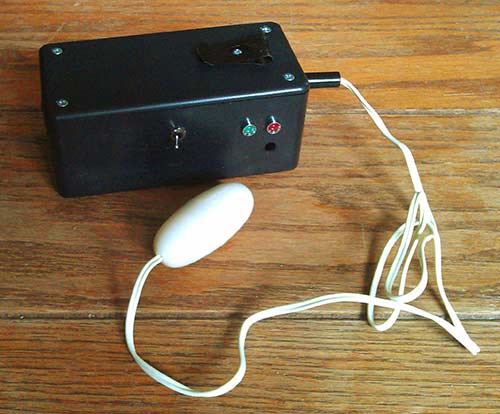
There are some design issues with this version that I plan to address in the future.
First, 9V batteries are BIG! The project could be shrunk down quite a bit by using a 12-volt "N"-sized battery like the kind used in some remote controls. These batteries are very small and can power the Arduino for a long time.
Second, the Arduino I'm using is pretty bulky itself. The next version will probably use either an Arduino Nano or a Teensy USB microcontroller board (an Arduino-like, but very tiny, prototyping board) as its brain. This will get the size of the main component down to less than a quarter of what it is now.
Third, I wasn't very careful with the interface components; I could probably get them significantly smaller with a bit of work (and more careful hot glueing).
But how did it work?
Ah, now that's the REAL question, isn't it? I wired up my first victim volunteer, when she and her hubby accompanied my partner and I and an assortment of other friends down to the farm to visit some three-week-old kittens.
She wrote up a rather lovely blog entry about her subjective experience with the Tormentor, so rather than repeating it, I'll just point you over there.
The biggest problem with the first version of the Tormentor was that the device was just too damn bulky. Part of this was the fault of using a 9V battery to run the microcontroller, but part of t was the fact that the Arduino Uno board I'm using is just plain big.
I mentioned this to a friend of mine who is also a micorocontroller hacker and general mad scientist. He suggested that I use a Teensy USB board in place of the Arduino, and even gave me a spare that he happened to have handy.
The name doesn't lie.
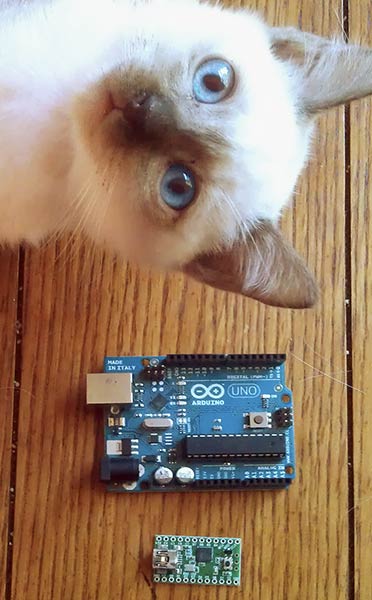
Size comparison, top to bottom: 9-week-old Tonkinese kitten, Arduino Uno, Teensy USB
The new version was rather a lot smaller--so small, in fact, that it fits easily into an Altoids tin with plenty of room to spare.
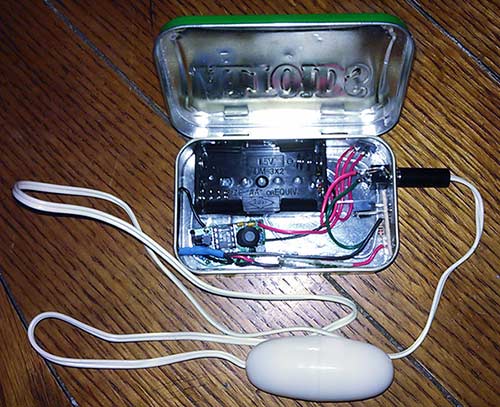
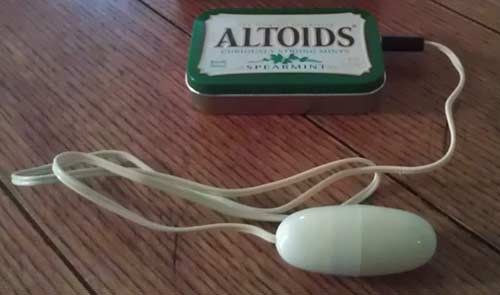
The Wiring software for the Tormentor prototype looks like this:
/*
Evil begins here
*/
int sexPin = 15; // Sex toy connected to pin
int ledpin = 6;
unsigned long randNum;
int randIntensity;
int randPattern;
int maxPattern = 9; // highest pattern number
void setup() {
randomSeed(analogRead(0));
pinMode(ledpin, OUTPUT);
pinMode (sexPin, OUTPUT);
Serial.begin(9600);
}
void loop() {
analogWrite (sexPin, 0); //Turn off toy
digitalWrite(ledpin, HIGH); //Turn off internal & external LED
randNum = random (1500,9000)*5; // Get a random number
Serial.print("Delaying: ");
Serial.println(randNum); //Debugging
delay (randNum);
randPattern=random(maxPattern)+1;
Serial.print("Pattern number: ");
Serial.println(randPattern); //Debugging
switch(randPattern) {
case 1:
// Run at random intensity for 10-45 seconds
randNum = random(1000,4500) * 10;
randIntensity = random (100,255)+1;
analogWrite (sexPin,randIntensity);
digitalWrite(ledpin, LOW);
break;
case 2:
// oh eh oh eh oh
analogWrite (sexPin, 127);
digitalWrite(ledpin, LOW);
delay (1000);
analogWrite (sexPin, 255);
digitalWrite(ledpin, LOW);
delay (1600);
analogWrite (sexPin, 127);
digitalWrite(ledpin, LOW);
delay (1000);
analogWrite (sexPin, 255);
digitalWrite(ledpin, LOW);
delay (1600);
analogWrite (sexPin, 127);
digitalWrite(ledpin, LOW);
delay (1000);
break;
case 3:
// bzz bzz (bzz) bzzzzzzzzzz
randNum=random(1,3)+1;
for (int i=0; i <= randNum; i++){
analogWrite (sexPin, 255);
digitalWrite(ledpin, LOW);
delay(300);
analogWrite (sexPin, 0);
digitalWrite(ledpin, HIGH);
delay(150);
}
randNum=random(2000,12000);
analogWrite(sexPin,255);
digitalWrite(ledpin, LOW);
delay(randNum);
break;
case 4:
// bzz bzz bzzzzzzzz bzz bzz bzz
analogWrite (sexPin, 127);
digitalWrite(ledpin, LOW);
delay(500);
analogWrite (sexPin, 0);
digitalWrite(ledpin, HIGH);
delay(100);
analogWrite (sexPin, 190);
digitalWrite(ledpin, LOW);
delay(500);
analogWrite (sexPin, 0);
digitalWrite(ledpin, HIGH);
delay(100);
randNum=random(2000,12000);
analogWrite(sexPin,255);
digitalWrite(ledpin, LOW);
delay(randNum);
randNum=random(4)+3;
for (int i=0; i <= randNum; i++){
analogWrite (sexPin, 255);
digitalWrite(ledpin, LOW);
delay(300);
analogWrite (sexPin, 0);
digitalWrite(ledpin, HIGH);
delay(150);
}
break;
case 5:
// pulse pulse pulse pulse pulse
randNum=random(8)+3;
for (int i=0; i <= randNum; i++){
randIntensity=random(100,255);
analogWrite (sexPin, randIntensity);
digitalWrite(ledpin, LOW);
delay(300);
analogWrite (sexPin, 0);
digitalWrite(ledpin, HIGH);
delay(150);
}
break;
case 6:
//fade
randNum=random(3000,6000);
digitalWrite(ledpin, LOW);
analogWrite (sexPin, 255);
delay(randNum);
for(int fadeValue = 255 ; fadeValue >= 0; fadeValue -=1) {
// sets the value (range from 0 to 255):
analogWrite(sexPin, fadeValue);
// wait for 30 milliseconds
delay(40);
}
break;
case 7:
//fadefade
randNum=random(1000,3000);
analogWrite (sexPin, 255);
digitalWrite(ledpin, LOW);
delay(randNum);
for(int fadeValue = 255 ; fadeValue >= 100; fadeValue -=1) {
analogWrite(sexPin, fadeValue);
delay(40);
}
for(int fadeValue = 255 ; fadeValue >= 0; fadeValue -=1) {
analogWrite(sexPin, fadeValue);
delay(40);
}
break;
case 8:
//fade up down
randNum=random(1000,4000);
digitalWrite (13,HIGH);
digitalWrite(12, HIGH);
for(int fadeValue = 0 ; fadeValue >= 255; fadeValue +=1) {
analogWrite(sexPin, fadeValue);
delay(40);
}
delay(randNum);
for(int fadeValue = 255 ; fadeValue >= 0; fadeValue -=1) {
analogWrite(sexPin, fadeValue);
delay(40);
}
break;
case 9:
// pulse up
for (int pulses=1 ; pulses <=10; pulses +=1) {
randIntensity=(pulses*20)+55;
analogWrite (sexPin, randIntensity);
digitalWrite(ledpin, LOW);
delay(300);
analogWrite (sexPin, 0);
digitalWrite(ledpin, HIGH);
delay(150);
}
break;
} //end switch
} //end loop
